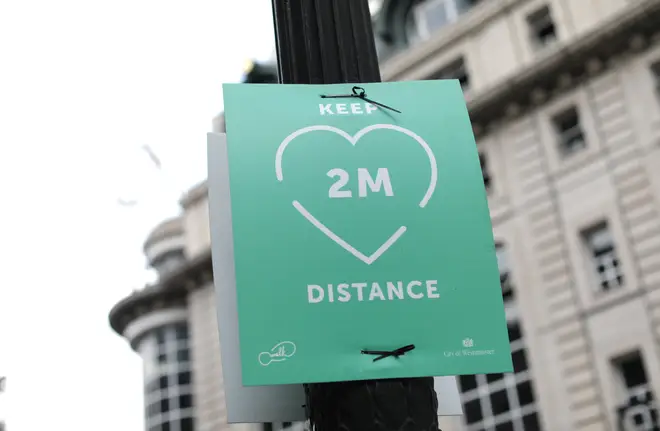
Iain Dale 7pm - 10pm
11 June 2020, 15:53

Boris Johnson has ordered an "urgent" review of the two-metre social distancing rule in a bid to open schools and get more businesses back up and running.
But what effect would reducing social distancing to one-metre have on the country and is it safe?
World Health Organisation (WHO) guidance allows people to remain apart by just one metre, rather than two.
The WHO advice is followed by other countries, such as France, Denmark and Singapore.
The rule is 1.5 metres in countries including Germany and Australia.

Will the 2 metre rule be relaxed?
SAGE reported that being exposed to the virus for six seconds at one metre is the same as being exposed for one minute at two metres.
The risk of being infected is around 13 per cent within 1m, but only 3 per cent beyond that distance.
For every extra metre of distance up to 3m, the risk is further reduced by half.
Sir Patrick Vallance said the two-metre restriction was "not a scientific rule" after he was asked whether it could be reduced to allow social distancing in schools to be relaxed.
The chief scientific adviser said: "It is not a rule, it is not a scientific rule - it is a risk-based assessment on when risk reduces.
"And the risks are associated with distance - so the risk falls after two metres - time, what mitigating factors you can put in place, which can include whether you are sitting side-by-side, back-to-back or face-to-face, whether you've got face covering, whether there is ventilation and other measures.
"And the absolute risk, ie. the number of people who have got the infection at any one time."
He added: "It is wrong to portray this as a scientific rule that says it is two metres or nothing - that is not what the advice has been and it is not what the advice is now."
Prof Chris Whitty previously said two metres is a “much safer distance” and that droplets can “be carried occasionally even beyond that.”

Boris Johnson: The easing of the lockdown is conditional
The Prime Minister is considering making the current two-metre social distancing restriction smaller to allow schools in England to reopen fully.
At Prime Minister's Questions on Wednesday, he promised to "keep that two-metre rule under constant review".
As well as helping to make it easier for schools to open, slashing the social distancing restriction could help pubs and restaurants to start-up again, with Business Secretary Alok Sharma this week accepting that "for economic reasons, businesses will want to take a look at this two-metre rule".
The British Beer and Pub Association is among the business organisations calling for the distancing rule to be reduced to one metre.
The two-metre rule will mean that only a third (12,500) of England’s pubs will be able to re-open on July 4, according to research by the BBPA.
This could leave up to 25,000 pubs closed with major concerns over when, if ever, they will be able to reopen.
Under one metre social distancing guidelines, 75 per cent (28,000) of England’s pubs would be able to re-open.

Keir Starmer questions Boris Johnson's coronavirus strategy
Reducing the two-metre rule to just one would allow schools to teach more pupils at the same time.
The Government had initially aimed for all pupils to have a month of teaching before the summer holidays, but the plan was scrapped this week.
Some schools said they did not have sufficient space or capacity to admit all pupils in the eligible year groups while also ensuring social distancing measures and limiting class sizes to 15.
Figures released by the Department for Education (DfE) on Tuesday showed that just over half (52 per cent) of primary schools in England had reopened to more children on Thursday last week.
Speaking in the House of Commons on Tuesday, Education Secretary Gavin Williamson said the government is still "working to bring all children back to class in September," following the coronavirus outbreak.
However, he said ministers will "continue to follow scientific advice" while implementing a "cautious phased return" to schools.
Listen & subscribe: Global Player | Apple Podcasts | Google Podcasts | Spotify
He told MPs: "While we are not able to welcome all primary children back for a full month before the summer, we continue to work with the sector on the next steps.
"We would like to see schools who have the capacity to bring back more children in those smaller class sizes, to do so, if they are able to, before the summer holidays.
"We will be working to bring all children back to school in September."
At the Downing Street news briefing on Wednesday, Mr Johnson said the Government had been forced to move "slower than we would have liked in some areas", including in reopening schools.
He said: "It is because the rate of infection is not quite low enough and because we are not able to change our social distancing advice, including smaller class sizes in schools, that we are not proceeding with our ambition to bring back all primary pupils at least for some weeks before the summer holidays.
"We're going to get all schools back in September if we possibly can, but it's going to be a big summer of catch up.
"We're going to keep making sure that kids get the remedial help that they need for the stuff that they've missed for months and months to come so that they genuinely make up for lost time."